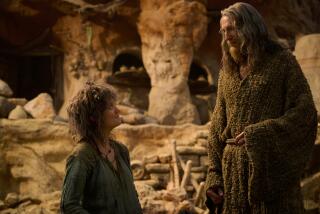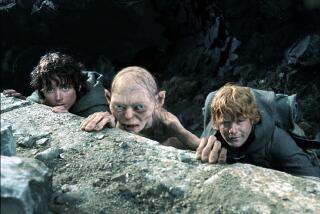Destiny approaches
- Share via
It took one ring to rule them all, and now there’s one film to end it all, to bring to a close the cinematic epic of our time, the one by which all others will be judged. “The Lord of the Rings: The Return of the King” has finally arrived.
Powerfully imagined two times over, first by the matchless fantasy mind of J.R.R. Tolkien and then by the bravura filmmaking of director Peter Jackson and a cast and crew that reached 2,400 souls, “The Return of the King” is a fitting climax to a story about the quest to rescue the world from evil that has had us profoundly in its grip from the start.
Like anything restlessly and eagerly anticipated, “The Return of the King” will inevitably be quibbled with. At 3 hours and 20 minutes, it is both formidably long and unsure where it ought to end. The film’s critical human moments include some of the strongest of the trilogy, but because “Return” by definition has to showcase battles that will literally end all battles, the brevity of those character beats at times threatens the critical human thread with unraveling.
That doesn’t happen, which is a tribute not only to this film but to the deep emotional connection with its numerous characters we’ve stored up and carry with us. In its belief that this story has meaning as well as excitement, “Return,” written by Fran Walsh & Philippa Boyens & Jackson, has made its made-up world as completely real on the psychological level as its up-to-the-moment visual effects have on the physical.
Not only have we spent hour after involving hour with these characters, but the actors who play them (and to whom they will likely be forever linked) have put in so much time with them -- literally years -- that they’ve to an unusual degree actually lived these parts.
To look at the faces of Elijah Wood as Frodo and Sean Astin as Sam, Ian McKellen as Gandalf and Viggo Mortensen as Aragorn, is to see the signs of triumphs and disappointments that only the genuine passage of time can create. As Jackson himself has said, “the moment you film a close-up of Ian McKellen, you don’t want to cut to a wide shot anymore because Ian is so compelling.”
While it can be easier (albeit considerably expensive) to come up with a persuasive physical reality than a psychological one, that shouldn’t detract from how much success the “Rings” team, led by production designer Grant Major and cinematographer Andrew Lesnie, has had in doing so here. This film’s crowning achievement is white-stoned Minas Tirith, the kingdom of Gondor’s 700-foot, seven-level city of kings that, in a smooth combination of miniatures and built sets, looks like a flabbergasting cross between an Italian hill town and a Beverly Hills wedding cake.
Though viewers of the trilogy have likely seen enough bad-tempered orcs to last them a lifetime, “Return” has done a remarkable job making the third part’s new creatures as convincing (in the case of the monstrous spider Shelob, arguably too much so) as they are fantastical. Most impressive are the fell beasts, bat-like flying dragons with 70-foot wingspans, and the mumakil, eight-stories-tall combat elephants that look as large as mountains. Most people just get out of the way.
Yet for all of this, it is as characteristic of “Return” as its predecessors that some of its most memorable moments are its simplest. The presenting of a newly forged sword to a key hero, the lighting of a series of signal fires to warn the neighboring kingdom of Rohan that Gondor is under attack, are successful precisely because they bring a kind of magical directness to the proceedings.
Similarly, “Return of the King” begins with a scene of two young men fishing that is almost deceptive in its artlessness. For one of the men is Smeagol, and this flashback to how he comes to possess the ring and how that object’s corrosive power gradually devolves him into the sniveling Gollum is a timely reminder of the ring’s ability to bend the minds of every creature.
More than the previous films, “Return of the King” has a sinister end of days feeling about it, a doomsday sensibility as the very skies seem to darken and it becomes clear that the climactic battle between the forces of good and the Dark Lord Sauron, he of the fiery, all-seeing eye, is only a matter of time.
As Gandalf, that master of the epigram, puts it, “things are now in motion that cannot be undone.”
The best hope of a positive outcome -- the quest of the hobbits Frodo and Sam to destroy the malevolent ring in the fires of Mt. Doom -- is, the wizard is forced to admit, “just a fool’s hope.”
Even Gandalf doesn’t really know what we soon find out: Things are going badly for this duo and their treacherous guide Gollum, a creature schizophrenically divided between his desire to do good and his pathological desire to possess the ring once again. Frodo, his mind weakened by the weight of carrying the ring, is increasingly not himself and prey to Gollum’ s insidious, Iago-like posturings. Thanks to the input of Andy Serkis, the creature lives up to the director’s claim that he’s “probably the most actor-driven digital creature that has ever been used in a film.” Aside from keeping an eye on the progress of this tormented trio, “Return” has two other plot strands to follow. The first involves Gandalf and the hobbit Pippin (Billy Boyd) as they try to rally Gondor to the fight against Sauron in the face of the opposition of its power-mad steward, Denethor (John Noble).
Also in the mix is the intrepid Aragorn, whose tasks are more complex still. He has to help rally the forces of Rohan, including the comely but powerful Eowyn (Miranda Otto), while still worrying about love-of-his-life Arwen (Liv Tyler) and coming to grips with aspects of his destiny that include a trip down the dreaded Paths of the Dead, where, not surprisingly, no one much wants to go.
One of the most satisfying aspects of “The Return of the King” is that some of the actors we’ve seen the most of do especially well here. McKellen makes the most of Gandalf’s moments, Mortensen increasingly becomes the epitome of heroic grace, and Astin brings the kind of dignity and quiet strength to Sam increasingly called for by the role.
With so many involving things on offer, it’s understandable that though “Return” opts to do without the book’s closing section detailing battles around the Shire, it still extends longer than it should. For filmmakers and viewers alike, a world this vivid is next to impossible to leave. As a model for how to bring substance, authenticity and insight to the biggest of adventure yarns, this trilogy will not soon, if ever, find its equal.
*
“The Lord of the Rings: The Return of the King”
MPAA rating: PG-13, for intense epic battle sequences and frightening images
Times guidelines: A monstrous spider is easily the most frightening element in any of the three films.
Elijah Wood...Frodo
Ian McKellen...Gandalf
Viggo Mortensen...Aragorn
Liv Tyler...Arwen
Sean Astin...Samwise Gamgee
Cate Blanchett...Galadriel
John Rhys-Davies...Gimli
Bernard Hill...King Theoden of Rohan
Billy Boyd...Pippin
Dominic Monaghan...Merry
Orlando Bloom...Legalos
Hugo Weaving...Elrond
Miranda Otto...Eowyn
Andy Serkis...Gollum/Smeagol
New Line Cinema presents a Wingnut Films production, released by New Line. Director Peter Jackson. Producers Barrie M. Osborne, Fran Walsh, Peter Jackson. Executive producers Robert Shaye, Michael Lynne, Mark Ordesky, Bob Weinstein, Harvey Weinstein. Screenplay by Fran Walsh & Philippa Boyens & Peter Jackson. Cinematographer Andrew Lesnie. Editor Jamie Selkirk. Costume designers Ngila Dickson, Richard Taylor. Music Howard Shore. Production designer Grant Major. Art directors Joe Bleakley, Phil Ivey, Simon Bright. Set decorators Dan Hennah, Alan Lee. Running time: 3 hour, 20 minutes.
In general release.
More to Read
Only good movies
Get the Indie Focus newsletter, Mark Olsen's weekly guide to the world of cinema.
You may occasionally receive promotional content from the Los Angeles Times.











